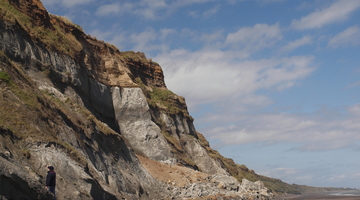Watch this animated video and find out more on how sedimentary rock near Whanganui records 50 cycles of sea level change, each lasting up to 100,000 years. Rocks were formed during warm interglacials, and partly eroded away during cold glacials.
Transcript
Warm interglacial period
During the warm interglacial period between ice ages, the sea level is high. Sediment is washed into the sea from nearby land, forming a new layer over old sedimentary rock.
Cooling period
In the next stage of the cycle, the Earth cools. Huge amounts of ice are formed, taking up water out of the sea. So the sea level drops by as much as one hundred metres. The latest sediments formed under water are exposed and become dry land.
Cold glacial period
Erosion eats away at the newly exposed land, removing the top part of the latest sediment layer.
Warming period
As the cycle continues, the Earth warms again. The ice melts and the sea level rises again, covering the eroded land surface. New sediments wash in and cover the old land surface.
Interglacial period
The junction between the newest layer and the older layer beneath is called an unconformity. It marks where rocks have been lost between one layer and the next. So each layer contains all that remains of the rock formed during a warm interglacial period. There are no rocks to mark cold glacial periods.


